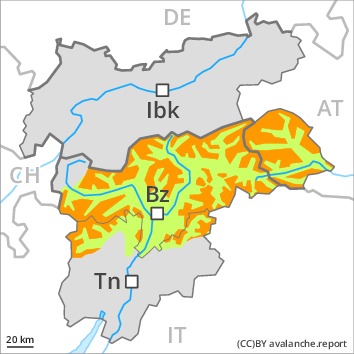
Danger level
 | treeline
|
Avalanche Problem
 | | Wind-drifted snow |
|  | |  |
 | | Persistent weak layer |
|  | |  |

Fresh wind slabs require caution. Weak layers in the upper part of the snowpack are treacherous.
Dry avalanches can be triggered in the weakly bonded old snow and reach large size in isolated cases. Remotely triggered avalanches are possible. Avalanche prone locations for dry avalanches are to be found in all aspects above the tree line. The avalanche prone locations are barely recognisable. Especially places where surface hoar has been covered with snow are treacherous. Whumpfing sounds and the formation of shooting cracks when stepping on the snowpack serve as an alarm indicating the danger.
The fresh wind slabs are easy to recognise but prone to triggering. The prevalence of such avalanche prone locations will increase with altitude, caution is to be exercised in particular adjacent to ridgelines and in gullies and bowls.
In addition a latent danger of gliding avalanches exists.
Meticulous route selection is important.
Snowpack
dp.6: cold, loose snow and wind
dp.8: surface hoar blanketed with snow
Precarious weak layers exist in the top section of the snowpack. The somewhat older wind slabs are lying on surface hoar in some places.
The northwesterly wind will transport the loosely bonded old snow. In the course of the day the wind slabs will increase in size moderately. The fresh wind slabs will be deposited on soft layers. As a consequence of low temperatures the snowpack can not consolidate.
Towards its base, the snowpack is well consolidated.
Tendency
Gradual increase in danger of dry avalanches as a consequence of new snow and wind, especially in the north.

Danger level
 | treeline
|
Avalanche Problem
 | | Wind-drifted snow |
|  | |  |
 | | Persistent weak layer |
|  | |  |

Wind slabs represent the main danger. Weak layers in the upper part of the snowpack are treacherous.
The fresh and older wind slabs are prone to triggering in all aspects above the tree line. In the course of the day these will increase in size additionally. Avalanches can in many places be released easily and reach medium size.
Avalanches can additionally be released in near-surface layers also. The avalanche prone locations are barely recognisable. Remotely triggered avalanches are possible. Especially places where surface hoar has been covered with snow are treacherous. Whumpfing sounds and the formation of shooting cracks when stepping on the snowpack serve as an alarm indicating the danger.
In addition a latent danger of gliding avalanches exists.
Backcountry touring calls for experience in the assessment of avalanche danger. Meticulous route selection is important.
Snowpack
dp.6: cold, loose snow and wind
dp.8: surface hoar blanketed with snow
In the north and in the northwest 5 to 10 cm of snow, and even more in some localities, will fall until late morning, in particular along the border with Tirol. In the south and in the southeast a little new snow. The strong wind will transport the fresh and old snow significantly. The brittle wind slabs will be deposited on soft layers.
Precarious weak layers exist in the top section of the snowpack. As a consequence of low temperatures the snowpack can not consolidate.
Towards its base, the snowpack is well consolidated.
Tendency
As a consequence of new snow and strong wind the prevalence and size of the avalanche prone locations will increase on Thursday, especially in the north.

Danger level
 | treeline
|
Avalanche Problem
 | | Wind-drifted snow |
|  | |  |
 | | Persistent weak layer |
|  | |  |

Fresh wind slabs require caution. Weak layers in the upper part of the snowpack are treacherous.
Dry avalanches can be triggered in the weakly bonded old snow and reach large size in isolated cases. Remotely triggered avalanches are possible. Avalanche prone locations for dry avalanches are to be found in all aspects above the tree line. The avalanche prone locations are barely recognisable. Especially places where surface hoar has been covered with snow are treacherous. Whumpfing sounds and the formation of shooting cracks when stepping on the snowpack serve as an alarm indicating the danger.
The fresh wind slabs are easy to recognise but prone to triggering. The prevalence of such avalanche prone locations will increase with altitude, caution is to be exercised in particular adjacent to ridgelines and in gullies and bowls.
In addition a latent danger of gliding avalanches exists.
Meticulous route selection is important.
Snowpack
dp.6: cold, loose snow and wind
dp.8: surface hoar blanketed with snow
Precarious weak layers exist in the top section of the snowpack. The somewhat older wind slabs are lying on surface hoar in some places.
The northwesterly wind will transport the loosely bonded old snow. In the course of the day the wind slabs will increase in size moderately. The fresh wind slabs will be deposited on soft layers. As a consequence of low temperatures the snowpack can not consolidate.
Towards its base, the snowpack is well consolidated.
Tendency
Gradual increase in danger of dry avalanches as a consequence of new snow and wind, especially in the north.











